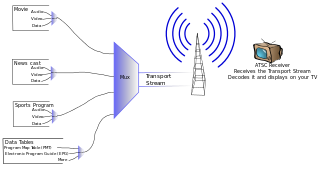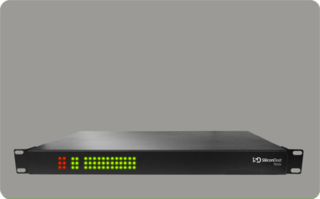
MPEG-2 is a standard for "the generic coding of moving pictures and associated audio information". It describes a combination of lossy video compression and lossy audio data compression methods, which permit storage and transmission of movies using currently available storage media and transmission bandwidth. While MPEG-2 is not as efficient as newer standards such as H.264/AVC and H.265/HEVC, backwards compatibility with existing hardware and software means it is still widely used, for example in over-the-air digital television broadcasting and in the DVD-Video standard.

The first American standard for analog television broadcast was developed by National Television System Committee (NTSC) in 1941. In 1961, it was assigned the designation System M.

Terrestrial television or over-the-air television (OTA) is a type of television broadcasting in which the signal transmission occurs via radio waves from the terrestrial (Earth-based) transmitter of a TV station to a TV receiver having an antenna. The term terrestrial is more common in Europe and Latin America, while in Canada and the United States it is called over-the-air or simply broadcast. This type of TV broadcast is distinguished from newer technologies, such as satellite television, in which the signal is transmitted to the receiver from an overhead satellite; cable television, in which the signal is carried to the receiver through a cable; and Internet Protocol television, in which the signal is received over an Internet stream or on a network utilizing the Internet Protocol. Terrestrial television stations broadcast on television channels with frequencies between about 52 and 600 MHz in the VHF and UHF bands. Since radio waves in these bands travel by line of sight, reception is generally limited by the visual horizon to distances of 64–97 kilometres (40–60 mi), although under better conditions and with tropospheric ducting, signals can sometimes be received hundreds of kilometers distant.

Advanced Television Systems Committee (ATSC) standards are an American set of standards for digital television transmission over terrestrial, cable and satellite networks. It is largely a replacement for the analog NTSC standard and, like that standard, is used mostly in the United States, Mexico, Canada, and South Korea. Several former NTSC users, such as Japan, have not used ATSC during their digital television transition, because they adopted other systems such as ISDB developed by Japan, and DVB developed in Europe, for example.
The Grand Alliance (GA) was a consortium created in 1993 at the behest of the Federal Communications Commission (FCC) to develop the American digital television and HDTV specification, with the aim of pooling the best work from different companies. It consisted of AT&T Corporation, General Instrument Corporation, Massachusetts Institute of Technology, Philips Consumer Electronics, David Sarnoff Research Center, Thomson Consumer Electronics, and Zenith Electronics Corporation. The Grand Alliance DTV system is the basis for the ATSC standard.

The Program and System Information Protocol (PSIP) is the MPEG and privately defined program-specific information originally defined by General Instrument for the DigiCipher 2 system and later extended for the ATSC digital television system for carrying metadata about each channel in the broadcast MPEG transport stream of a television station and for publishing information about television programs so that viewers can select what to watch by title and description. Its FM radio equivalent is Radio Data System (RDS).

1080p is a set of HDTV high-definition video modes characterized by 1,920 pixels displayed across the screen horizontally and 1,080 pixels down the screen vertically; the p stands for progressive scan, i.e. non-interlaced. The term usually assumes a widescreen aspect ratio of 16:9, implying a resolution of 2.1 megapixels. It is often marketed as Full HD or FHD, to contrast 1080p with 720p resolution screens. Although 1080p is sometimes informally referred to as 2K, these terms reflect two distinct technical standards, with differences including resolution and aspect ratio.
The Technology and Engineering Emmy Awards, or Technology and Engineering Emmys, are one of two sets of Emmy Awards that are presented for outstanding achievement in engineering development in the television industry. The Technology and Engineering Emmy Awards are presented by the National Academy of Television Arts and Sciences (NATAS), while the separate Primetime Engineering Emmy Awards are given by its sister organization the Academy of Television Arts & Sciences (ATAS).

An ATSCtuner, often called an ATSC receiver or HDTV tuner, is a type of television tuner that allows reception of digital television (DTV) television channels that use ATSC standards, as transmitted by television stations in North America, parts of Central America, and South Korea. Such tuners are usually integrated into a television set, VCR, digital video recorder (DVR), or set-top box which provides audio/video output connectors of various types.

HDHomeRun is a network-attached digital television tuner box, produced by the company SiliconDust USA, Inc.
ATSC-M/H is a U.S. standard for mobile digital TV that allows TV broadcasts to be received by mobile devices.

The Advanced Television Systems Committee(ATSC) is an international nonprofit organization developing technical standards for digital terrestrial television and data broadcasting. ATSC's 120-plus member organizations represent the broadcast, broadcast equipment, motion picture, consumer electronics, computer, cable, satellite and semiconductor industries.
WDPM-DT is a religious television station licensed to Mobile, Alabama, United States, serving southwest Alabama and northwest Florida as an owned-and-operated station of the Daystar Television Network. The station's transmitter is located near Robertsdale, Alabama.
KZHO-LD, virtual channel 38, is a low-powered television station serving Houston, Texas, United States that is licensed to Lake Jackson. The station is owned by the Hispanic Christian Community Network.
KEHO-LD, virtual channel 32, is a low-powered Court TV-affiliated television station licensed to Houston, Texas, United States. Owned by Innovate Corp, it is a sister station to Spanish religious station KZHO-LD. The station's transmitter is located on Clara Road north of Jacinto City.
ATSC 3.0 is a major version of the ATSC standards for television broadcasting created by the Advanced Television Systems Committee (ATSC). It is the first "all IP" broadcast standard and operates close to the 'Shannon limit'.
The 60th Technology and Engineering Emmy Awards was held on January 8, 2009 at the 2009 International Consumer Electronics Show in Las Vegas. CEO of Verizon Communications, Ivan Seidenberg received the Lifetime Achievement Award
MPEG-H 3D Audio, specified as ISO/IEC 23008-3, is an audio coding standard developed by the ISO/IEC Moving Picture Experts Group (MPEG) to support coding audio as audio channels, audio objects, or higher order ambisonics (HOA). MPEG-H 3D Audio can support up to 64 loudspeaker channels and 128 codec core channels.
Dolby AC-4 is an audio compression technology developed by Dolby Laboratories. Dolby AC-4 bitstreams can contain audio channels and/or audio objects. Dolby AC-4 has been adopted by the DVB project and standardized by the ETSI.







